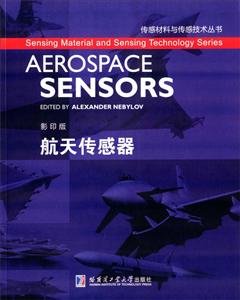航天传感器
内容简介
[
《航天传感器(影印版)》根据作者40多年来从事航空—航天飞行器结构试验和应变测量技术的体会,收集了国内外相关资料,以词目的形式汇编成册,以供从事航空—航天飞行器结构试验和应变测量技术,以及相应的工程结构试验和应变测量的各类技术人员参考。
]
目录
SERIES PREFACEPREFACEACKNOWLEDGMENTSABOUT THE SERIES EDITORABOUT THE EDITOR1 INTRODUCTION1.1 General Considerations1.1.1 Types of Aerospace Vehicles and Missions1.1.2 The Role of Sensors and Control Systems in Aerospace1.1.3 Specific Design Criteria for Aerospace Vehicles and their Sensors1.1.4 Physical Principles Influencing Primary Aerospace Sensor Design1.1.5 Reference Frames Accepted in Aviation and Astronautics1.2 Characteristics and Challenges of the Atmospheric Environment1.2.1 Components of the Earth’s Atmosphere1.2.2 Stationary Models of the Atmosphere1.2.3 Anisotropy and Variability in the Atmosphere1.2.4 Electrical Charges in the Atmosphere1.2.5 Electromagnetic Wave Propagation in the Atmosphere1.2.6 Geomagnetism1.2.7 The Planetary Atmosphere1.3 Characteristics and Challenges of the Space Environment1.3.1 General Considerations1.3.2 Near—Earth Space1.3.3 Circumsolar (Near—Sun) Space1.3.4 Matter in Space1.3.5 Distances and Time Scales in Deep SpaceReferences2 AIR PRESSURE—DEPENDENT SENSORS2.1 Basic Aircraft Instrumentation2.2 Fundamental Physical Properties of Airflow2.2.1 Fundamental Airflow Physical Property Definitions2.2.1.1 Pressure2.2.1.2 Air Density2.2.1.3 Temperature2.2.1.4 Flow Velocity2.2.2 The Equation of State for a Perfect Gas2.2.3 Extension o fDefinitions: Total, Dynamic, Static, and Stagnation2.2.4 The Speed of Sound and Mach Number2.2.4.1 The Speed of Sound2.2.4.2 Mach Number and Compressibility2.2.5 The Source of Aerodynamic Forces2.3 Altitude Conventions2.4 Barometric Altimeters2.4.1 Theoretical Considerations2.4.1.1 The Troposphere2.4.1.2 The Stratosphere2.4.2 Barometric Altimeter Principles and Construction2.4.3 Barometric Altimeter Errors2.4.3.1 Methodical Errors2.4.3.2 Instrumental Errors2.5 Airspeed Conventions2.6 The Manometric Airspeedlndicator2.6.1 Manometric Airspeedlndicator Principles and Construction2.6.2 Theoretical Considerations2.6.2.1 Subsonic Incompressible Operation2.6.2.2 Subsonic Compressible Operation2.6.2.3 Supersonic Operation2.6.3 Manometric Airspeed Indicator Errors2.6.3.1 Methodical Errors2.6.3.2 Instrumental Errors2.7 The Vertical Speed Indicator (VSI)2.7.1 VSI Principles and Construction2.7.2 Theoretical Considerations2.7.2.1 Lag Rate (Time Constant)2.7.2.2 Sensitivity to Mach Number2.7.2.3 Sensitivity to Altitude2.7.3 VSI Errors2.8 Angles of Attack and Slip2.8.1 The Pivoted Vane2.8.2 The Differential Pressure Tube2.8.3 The Null—Seeking Pressure TubeReferencesAppendix3 RADAR ALTIMETERS3.1 Introduction3.1.1 Definitions3.1.2 Altimetry Methods3.1.3 General Principles of Radar Altimetry3.1.4 Classification by Different Features3.1.5 Application and Performance Characteristics3.1.5.1 Aircraft Applications3.1.5.2 Spacecraft Applications3.1.5.3 Military Applications3.1.5.4 Remote Sensing Applications3.1.6 Performance Characteristics3.2 Pulse Radar Altimeters3.2.1 Principle of Operation3.2.2 Pulse Duration3.2.3 Tracking Altimeters3.2.4 Design Principles3.2.5 Features of Altimeters with Pulse Compression3.2.6 Pulse Laser Altimetry3.2.7 Some Examples3.2.8 Validation3.2.9 Future Trends3.3 Continuous Wave Radar Altimeters3.3.1 Principles of Continuous Wave Radar3.3.2 FMCW Radar Waveforms3.3.3 Design Principles and Structural Features3.3.3.1 Local Oscillator Automatic Tuning3.3.3.2 Single—Sideband Receiver Structure3.3.4 The Doppler Effect3.3.5 Alternative Measuring Devices for FMCW Altimeters3.3.6 Accuracy and Unambiguous Altitude3.3.7 Aviation Applications3.4 Phase Precise Radar Altimeters3.4.1 The Phase Method of Range Measurement3.4.2 The Two—Frequency Phase Method3.4.3 Ambiguity and Accuracy in the Two—Frequency Method3.4.4 Phase Ambiguity Resolution3.4.5 Waveforms3.4.6 Measuring Devices and Signal Processing3.4.7 Remarks on the Accuracy of CW and Pulse Radar Altimeters3.5 Radioactive Altimeters for Space Application3.5.1 Motivation and History3.5.2 Physical Bases3.5.2.1 Features of Radiation3.5.2.2 Generators of Photon Emission3.5.2.3 Receivers3.5.2.4 Propagation Features3.5.3 Principles of Operation3.5.4 Radiation Dosage3,5.5 Examples of Radioisotope AltimetersReferences4 AUTONOMOUS RADIO SENSORS FOR MOTION PARAMETERS4.1 Introduction4.2 Doppler Sensors for Ground Speed and Crab Angle4.2.1 Physical Basis and Functions4.2.2 Principle of Operation4.2.3 Classification and Features of Sensors for Ground Speed and Crab Angle4.2.4 Generalized Structural Diagram for the Ground Speed’and Crab Angle Meter4.2.5 Design Principles4.2.6 Sources of Doppler Radar Errors4.2.7 Examples4.3 Airborne Weather Sensors4.3.1 Weather Radar as Mandatory Equipment of Airliners and Transport Aircraft4.3.2 Multifunctionality of Airborne Weather Radar4.3.3 Meteorological Functions of AWR4.3.4 Principles ofDWP Detection with AWR4.3.4.1 Developing Methods of DWP Detection4.3.4.2 Cumulonimbus Clouds and Heavy Rain4.3.4.3 Turbulence Detection4.3.4.4 Wind Shear Detection4.3.4.5 Hail Zone Detection4.3.4.6 Probable Icing—in—flight Zone Detection4.3.5 Surface Mapping4.3.5.1 Comparison of Radar and Visual Orientation4.3.5.2 The Surface—Mapping Principle4.3.5.3 Reflecting Behavior ofthe Earth’s Surface4.3.5.4 The Radar Equation and Signal Correction4.3.5.5 Automatic Classification of Navigational Landmarks4.3.6 AWR Design Principles4.3.6.1 The Operating Principle and Typical Structure of AWR4.3.6.2 AWR Structures4.3.6.3 Performance Characteristics: Basic Requirements4.3.7 AWR Examples4.3.8 Lightning Sensor Systems: Stormscopes4.3.9 Optical Radar4.3.9.1 Doppler Lidar4.3.9.2 Infrared Locators and Radiometers4.3.10 The Integrated Localization of Dangerous Phenomena4.4 Collision Avoidance Sensors4.4.1 Traffic Alert and Collision Avoidance Systems (TCAS)4.4.1.1 The Purpose4.4.1.2 A Short History4.4.1.3 TCAS Levels of Capability4.4.1.4 TCAS Concepts and Principles of Operation4.4.1.5 Basic Components4.4.1.6 Operation4.4.1.7 TCAS Logistics4.4.1.8 Cockpit Presentation4.4.1.9 Examples of System Implementation4.4.2 The Ground Proximity Warning System (GPWS)4.4.2.1 Purpose and Necessity4.4.2.2 GPWS History, Principles, and Evolution4.4.2.3 GPWS Modes4.4.2.4 Shortcomings of Classical GPWS4.4.2.5 Enhanced GPWSs4.4.2.6 Look—Ahead Warnings4.4.2.7 Implementation ExamplesReferences……5 DEVICES AND SENSORS FOR LINEAR ACCELERATION MEASUREMENT6 GYROSCOPIC DEVICES AND SENSORS7 COMPASSES8 PROPULSION SENSORS9 PRINCIPLES AND EXAMPLES OF SENSORINTEGRATIONEPILOGUEINDEX
封面

书名:航天传感器
作者:Alexander Nebylov[主编
页数:384
定价:¥120.0
出版社:哈尔滨工业大学出版社
出版日期:2015-06-01
ISBN:9787560350578
PDF电子书大小:59MB 高清扫描完整版
